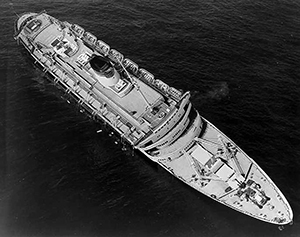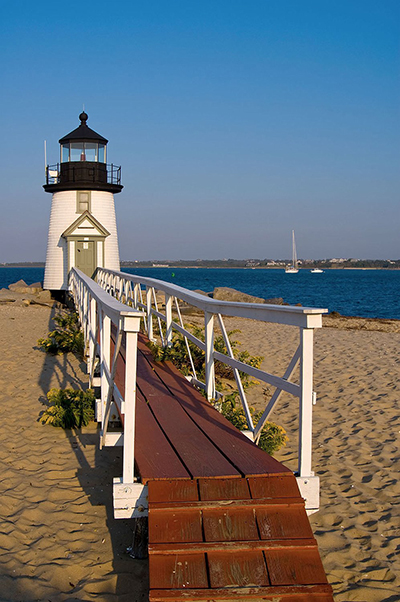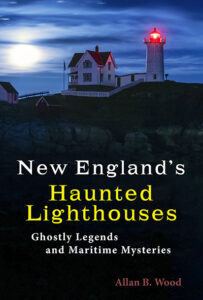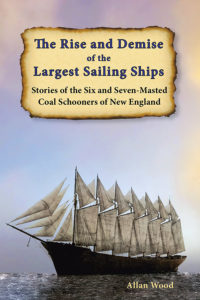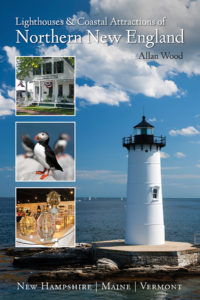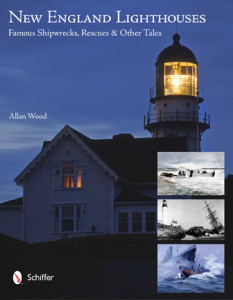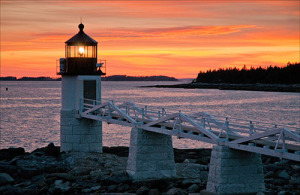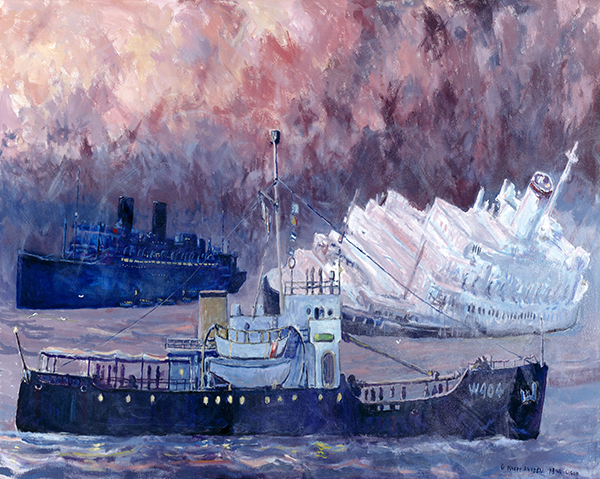
Andrea Doria Painting by artist Harry Ahysen. Image courtesy of the Ahysen family and the US Coast Guard
The Wreck of the Andrea Doria Off Nantucket Island in Massachusetts Became One of the Greatest Coordinated Sea Rescues
In dense fog on July 25, 1956, around 11 p.m., the nearly 700-foot passenger liner Andrea Doria, bound for New York, was rammed broadside by the 528-foot-long Swedish steamer Stockholm. The collision occurred 50 miles south of Nantucket Island, Massachusetts. In one of the most extraordinary coordinated rescue efforts between vessels and rescue services, all but 46 of the nearly 1,700 people on board were saved.
On July 17, 1956, the Andrea Doria left Genoa, Italy, sailing west and heading to New York City. On board were 1,134 passengers and 572 crew members. Of all Italy’s ships at the time, the Andrea Doria was the most prominent, fastest, and supposedly safest vessel afloat. On the last evening of her voyage, the Andrea Doria encountered fog. Captain Piero Calamai, a 40-year veteran, ordered the foghorn to be blown repeatedly. However, he did not significantly reduce the ship’s speed, which would only have enabled the boat to stop within a 3-mile range. At the same time, the Stockholm, which had left New York that morning, was sailing east, bound for Sweden.
Johan-Ernst Carstens, the Stockholm’s third mate who was commanding the bridge, turned his ship to the right of the Doria from information he received from an incorrect radar reading, believing the Doria to be 14 miles away instead of its actual location only 4 miles away. He failed to signal the maneuver with his ship’s whistle, putting the two vessels on a collision course.
When the Andrea Doria emerged from the fog, the crew saw the oncoming lights of the Stockholm. Captain Calamai of the Andrea Doria saw the Stockholm’s lights and realized it was turning directly into the Doria. Panicking, Calamai ordered to make a hard left turn in hopes of avoiding the approaching ship. This became the fatal move because it exposed the Doria’s side to the bow of the Stockholm. The situation was only made worse because the vessel did not communicate by whistle or radio, so instead of trying to sail away when each spotted the other, they turned towards one another and collided. The Stockholm crashed into the Andrea Doria, killing 45 people instantly, along with five crewmen of the Stockholm. The impact opened such a gaping hole in the Doria’s side that within minutes, the ship was leaning dangerously on her right side, flooding the ship’s watertight compartments that helped to keep the monstrous vessel afloat. As a result, at least half of the lifeboats on the Andrea Doria could not be lowered because the ship’s right side was listing dangerously into the water.
The Coast Guard monitoring station on Long Island quickly picked up the first SOS messages sent from both the Andrea Doria and the Stockholm. They could then put into action probably the most effective rescue operations of the time. In addition, other ships in the area, the Cape Ann, the Navy Transport Pvt. William H. Thomas and the tidewater tanker Robert E. Hopkins were all hurrying to assist in the rescue effort, although they only had a few lifeboats.
The captain of the Andrea Doria radioed: “Danger immediate. Need boats to evacuate 1,000 persons and 500 crew members. We need boats.” The captain of the Ile de France, Baron Raoul de Beaudan, was only 44 miles from the accident site and received the Doria’s distress signal. The French liner Ile de France had just left New York with many passengers and was heading for France. The captain quickly turned his ship around to help in the rescue effort, as he had plenty of lifeboats aboard. All these ships helped to keep this accident from becoming an even greater disaster, but the Ile de France rescued the most significant number of passengers. With repeated radio attempts of the Andrea Doria’s captain to have the Stockholm aid in the rescue, the captain of the Stockholm, Harry Gunner Nordenson, was also concerned with the wellbeing of his ship. After evaluating that his boat would not sink, he launched seven lifeboats to aid the Andrea Doria’s passengers. The Stockholm left the collision scene and, with massive damage to its bow, slowly made it back safely to New York.
On board the Stockholm, a sailor discovered a 14-year-old girl named Linda Morgan entangled in the wreckage near the bow. He could not find her name on the Stockholm’s passenger list and was surprised when she told him she was a passenger on the Andrea Doria. She had been thrown from her bed on the Andrea Doria onto the Stockholm during the collision. She was known afterward as the “miracle child,” although her half-sister and stepfather died from injuries suffered on the Andrea Doria.
As the night wore on, rescue ships and the Coast Guard arrived to take the passengers to safety. Some passengers panicked and jumped overboard, to be later picked up in the lifeboats, while many slid down ropes and makeshift steps to the security of their rescuers. Many families became separated from each other in the chaos. By 6:00 a.m., all the survivors had been placed onto the rescue ships that came to help and were heading to the shore.
The Doria’s remaining crew began to abandon the ship, along with Captain Calamai, by 9 a.m. The great liner began to sink at 9:45 a.m., and by 10:09 that morning, news crews witnessed the Andrea Doria entirely disappearing from the site. It sank eleven hours after the collision with the Stockholm. With such a dramatic rescue effort, all but 46 (45 were killed instantly on impact) of the nearly 1,700 people on board were saved.
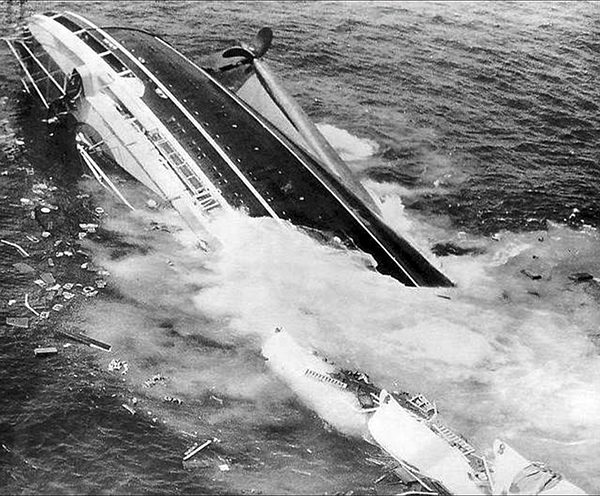
Andrea Doria sinking hours after colliding with the Swedish ship Stockholm off the coast of Nantucket Island. Photo by Harry A. Trask.
Aftermath
As the Andrea Doria sank beneath the waves and came to rest 160 feet below the surface southwest of Nantucket Island, accusations began to fly about who was responsible for the collision. While Captain Calamai of the Andrea Doria swore that there was a thick fog that evening, the Stockholm claimed that there was no fog. However, in July, with such extreme weather quite typical in and around the Cape Cod region, both men may have been telling the truth. The owners of both ships settled out of court.
For years afterward, it was commonly held that the Andrea Doria and its captain were to blame for the accident. More recent investigations have cleared Captain Calamai, who died before being vindicated. Although this was a tragic event, with so many mariners coordinating to rescue those in peril, it became one of history’s greatest coordinated sea rescues. Much was learned from the event to train those involved with future rescue efforts. As a result of this disaster, improved radar training was required, and ships were required to make contact by radio. In a bit of irony, two years after the collision, by 1958, airlines began offering nonstop jet travel between the United States and Europe, indicating an end to the passenger liner era.
The Andrea Doria lies in about 160 feet of water with strong currents and low visibility. The site is a popular dive site for extremely professional recreational divers. Still, it is considered very challenging, and some divers have perished exploring in these bottomless waters over the years.
About the Coast Guard Artist Harry Ahysen
The painting above, Andrea Doria, was created by artist Harry Ahysen. Ahysen was named the State Artist of Texas in 1980 and 1981 and one of ten official Coast Guard artists. Seven of his works are a part of the Coast Guard Collection. He has over a dozen murals in various locations throughout the county, and his art can be found in museums and collections worldwide. He was also a full-time professor teaching over 31 years in the art department at Sam Houston State University. He was Distinguished Professor Emeritus, the first ever bestowed by the University on a Professor of Art. Check out the work of this fantastic man.
About Photographer Harry A. Trask
Trask was a staff photographer for the Boston Evening Traveler when he photographed the cruise ship Andrea Doria as it started sinking off the coast of Nantucket, Massachusetts. Trask was using a large and heavy 4×5 Speed Graphic sheet film camera, and the image was taken from a small airplane. His sequence of images was published in many media outlets, including Life magazine. The photo above was the second in the sequence, winning him a Pulitzer Prize for photography in 1957.
Have a great summer,
Allan Wood
Exploring Nantucket Island in Massachusetts
Nantucket Island is one of two main islands, the other being Martha’s Vineyard Island, off the Cape Cod coastline in Massachusetts. Nantucket Island offers pristine beaches, specialty shops, and museums and hosts many events for tourists from around the world who come to visit. You’ll also find the oldest grist mill there as well. No traffic lights on the island offer a classic rural island experience. There are three lighthouses on the island, which you can drive to. Brant Point Lighthouse in Nantucket Harbor, which can be found close to the ferry dock. Sankaty Head Lighthouse is situated at the end of the quiet Siasconset Golf Course, where visitors can play dressed as they are and enjoy views of the lighthouse. Great Point Lighthouse is located in the Coskata-Coatue Wildlife Refuge, a few miles away. A naturalist guide provides visitors a tour on a four-wheel sand buggy to learn about the area’s geology, ecology, and history. Tours to climb the tower of Great Point lighthouse are also provided.
Here are some of my favorite lighthouse photos of both Nantucket Island and Martha’s Vineyard Island, in Massachusetts.
Books to Explore
New England’s Haunted Lighthouses:
Ghostly Legends and Maritime Mysteries
Discover the mysteries of New England’s haunted lighthouses! Uncover ghostly tales of lingering keepers, victims of misfortune or local shipwrecks, lost souls, ghost ships, and more. Many of these accounts begin with actual historical events that later lead to unexplained incidents.
Immerse yourself in the tales associated with these iconic beacons!
The Rise and Demise of the Largest Sailing Ships:
Stories of the Six and Seven-Masted Coal Schooners of New England.
In the early 1900s, New England shipbuilders constructed the world’s largest sailing ships amid social and political reforms. These giants were the ten original six-masted coal schooners and one colossal seven-masted vessel, built to carry massive quantities of coal and building supplies and measured longer than a football field! This self-published book, balanced with plenty of color and vintage images, showcases the historical accounts that followed these mighty ships.
Available also from bookstores in paperback, hardcover, and as an eBook for all devices.

Book – Lighthouses and Coastal Attractions in Southern New England: Connecticut, Rhode Island, Massachusetts
Lighthouses and Coastal Attractions of Southern New England:
Connecticut, Rhode Island, and Massachusetts.
This 300-page book provides memorable human interest stories from each of the 92 lighthouses. You can explore plenty of indoor and outdoor coastal attractions, including whale-watching excursions, lighthouse tours, windjammer sailing tours, parks, museums, and even lighthouses where you can stay overnight. You’ll also find plenty of stories of hauntings around lighthouses.
Lighthouses and Coastal Attractions of Northern New England:
New Hampshire, Maine, and Vermont.
This 300-page book provides memorable human interest stories from each of the 76 lighthouses. It also describes and provides contact info for plenty of indoor and outdoor coastal attractions and tours. These include whale watching, lighthouse tours, unique parks, museums, and lighthouses where you can stay overnight. There are also stories of haunted lighthouses in these regions.
New England Lighthouses:
Famous Shipwrecks, Rescues & Other Tales
There are over 40 stories, including the rescue of the Andrea Doria. This image-rich book also contains vintage images provided by the Coast Guard and various organizations and paintings by six famous Coast Guard artists.
You can purchase this book and the lighthouse tourism books from the publisher Schiffer Books or in many fine bookstores such as Barnes and Noble.
Join, Learn, and Support The American Lighthouse Foundation
For more detailed info on any of my books, visit my Lighthouse Books page.
Copyright © Allan Wood Photography; do not reproduce without permission. All rights reserved.
